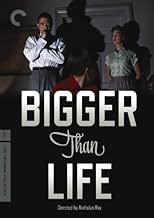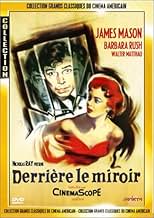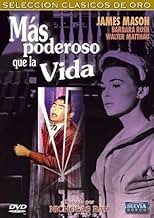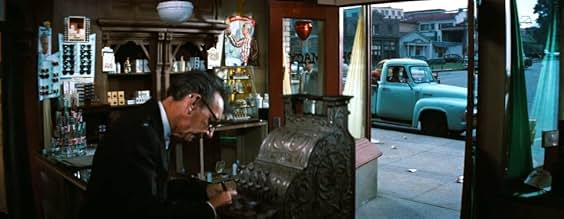IMDb-BEWERTUNG
7,4/10
8613
IHRE BEWERTUNG
Füge eine Handlung in deiner Sprache hinzuA seriously-ill schoolteacher becomes dependent on a miracle drug that begins to affect his sanity.A seriously-ill schoolteacher becomes dependent on a miracle drug that begins to affect his sanity.A seriously-ill schoolteacher becomes dependent on a miracle drug that begins to affect his sanity.
- Auszeichnungen
- 2 Nominierungen insgesamt
Robert F. Simon
- Dr. Norton
- (as Robert Simon)
David Bedell
- X-Ray Doctor
- (Nicht genannt)
Gail Bonney
- Mother at PTA Meeting
- (Nicht genannt)
Harold Bostwick
- Gentleman
- (Nicht genannt)
Lovyss Bradley
- Churchgoer
- (Nicht genannt)
Mary Carroll
- Mother at PTA Meeting
- (Nicht genannt)
Virginia Carroll
- Mrs. Jones
- (Nicht genannt)
Mary Carver
- Saleslady
- (Nicht genannt)
Betty Caulfield
- Mrs. LaPorte
- (Nicht genannt)
Empfohlene Bewertungen
This is an excellent movie. I saw it once, and I never wish to see it again. I grew up in a household like this, only there was never a solution to my father's mania, depression, and incredible anger.
About all I can say about Mr Mason's performance, and that of Ms Rush, is that they could have been my parents, and I could have been that kid. It never got to the point where I was offered up like Isaac, but the rest of it was right, right down to the speech where the father condemns all children because they're ignorant. I'd heard that one. His wife was helpless; they all are.
I do not know where the screenwriters got their dialog, but I hope they didn't learn it the way I did. As it happened, I was terrified and transfixed while watching it, only calming down after the father realized that something was wrong, and vowed to correct it, and there was a means of correcting it.
When the movie was over--I don't know if I watched it in the theater or on TV--I had to go home, where there was still rage, and no solution to it. I would have been nine years old.
There was a time that I wanted my parents to see that movie, in the hope that they'd realize that this was how they acted, and stop it.
It never happened. They were divorced years later. My father was angry and crazy right up to the day he died three years ago. My mother, in her nursing home in Cleveland, maintains that I must be making it all up.
M Kinsler
About all I can say about Mr Mason's performance, and that of Ms Rush, is that they could have been my parents, and I could have been that kid. It never got to the point where I was offered up like Isaac, but the rest of it was right, right down to the speech where the father condemns all children because they're ignorant. I'd heard that one. His wife was helpless; they all are.
I do not know where the screenwriters got their dialog, but I hope they didn't learn it the way I did. As it happened, I was terrified and transfixed while watching it, only calming down after the father realized that something was wrong, and vowed to correct it, and there was a means of correcting it.
When the movie was over--I don't know if I watched it in the theater or on TV--I had to go home, where there was still rage, and no solution to it. I would have been nine years old.
There was a time that I wanted my parents to see that movie, in the hope that they'd realize that this was how they acted, and stop it.
It never happened. They were divorced years later. My father was angry and crazy right up to the day he died three years ago. My mother, in her nursing home in Cleveland, maintains that I must be making it all up.
M Kinsler
James Mason becomes "Bigger than Life" in this 1956 Nicholas Ray film that also stars Barbara Rush and Walter Matthau. Mason plays Ed Avery, a schoolteacher who also is a part-time cab dispatcher. He is suffering from severe spasms that are getting worse.
Ed learns that he has a terminal illness that perhaps can be cured with a steroid, cortisone. He is helped, but he also begins to suffer from mood swings and depression and, as he takes more and more, veers completely out of control. Barbara Rush plays his suffering wife, and Walter Matthau is a family friend and coworker.
I actually had a family member who went into profound depressions because of continuing to take black market cortisone, so this film resonated with me. Mason, who produced the film, is terrifying. Barbara Rush is very good, though her character puts up with an awful lot before she makes a move. Matthau is good in a supporting role, but roles showcasing his true strengths as an actor were a few years away.
This is much more than a cautionary tale about steroids, which need to be taken and tapered off very carefully. In his cortisone-induced mindset, Ed Avery spouts off on the problems in society, very unusual in the repressed '50s. His ideas are a tad over the top, but there's a good kernel in them. Ray always did well with a rebellious mindset.
Ed learns that he has a terminal illness that perhaps can be cured with a steroid, cortisone. He is helped, but he also begins to suffer from mood swings and depression and, as he takes more and more, veers completely out of control. Barbara Rush plays his suffering wife, and Walter Matthau is a family friend and coworker.
I actually had a family member who went into profound depressions because of continuing to take black market cortisone, so this film resonated with me. Mason, who produced the film, is terrifying. Barbara Rush is very good, though her character puts up with an awful lot before she makes a move. Matthau is good in a supporting role, but roles showcasing his true strengths as an actor were a few years away.
This is much more than a cautionary tale about steroids, which need to be taken and tapered off very carefully. In his cortisone-induced mindset, Ed Avery spouts off on the problems in society, very unusual in the repressed '50s. His ideas are a tad over the top, but there's a good kernel in them. Ray always did well with a rebellious mindset.
"We are dabbling in the unknown with dangerously potent tools." That is from the magazine article on which this film is based: "Ten Feet Tall," by Berton Roueché, from his brilliant "Annals of Medicine" series in The New Yorker (10 September 1955). Before I watched this Nicholas Ray film for the 2nd time, I read the original article and was quite astonished to find that the film is both faithful and unfaithful to the truth, and in surprising ways.
The most stunning thing is how quickly Ed (James Mason) is affected by the cortisone he is given to treat his rare and dire disease, a typically fatal inflammation of the arteries. I doubted that the derangement that made him feel "ten feet tall" would have happened as quickly as in the movie, which needs to get the plot going.
Well, I was wrong. The Long Island teacher on whom the article was based had a psychotic break almost as soon as he started taking the corticosteroid. The entire episode of his psychosis lasted only three weeks, but during that time, he was a terrifying presence. His threatening, dictatorial behavior toward his wife and son, not to mention his colleagues, were, yes, exaggerated for dramatic effect (especially the scorn he heaps on his wife), but Mason's portrayal is strikingly close to the real teacher's experience: the madly impulsive spending, the manic speeches and wild philosophical brainstorms, as well as his demand to be absolute ruler in his home and his unveiled contempt for everyone because they're all fools, except him.
James Mason, Barbara Rush, and Walter Matthau do solid work, as does Christopher Olsen, a child actor who also worked with Hitchcock, Cukor, and Sirk. Much has been said about Nicholas Ray's choices as director, and what interests me most is the ways he chose to be unfaithful to the original story.
First, location. Although the actual teacher lived in Forest Hills in Queens, "Bigger than Life" is set in a nameless suburbia, and it was filmed it in color for the big screen even though it's a domestic drama of the sort that was still shot in black-and-white at the time. Much has been made of those two choices, which are taken to be a commentary on stifling, conformist suburban lives in the 1950s. But I think Ray's decision to move it to a more typical American landscape than New York City, and to treat it as a big-screen color feature, had to do with the dramatic weight of the subject: drugs that save lives can cripple them at the same time, and the film has strong references to the deep shame that was (and to some extent still is) attached to mental illness. The wife won't even hear the word psychiatrist.
Second, the doctors. In the movie, Ed tricks doctors and druggists to increase his intake of cortisone-- if he feels ten feet tall on one pill, why not take two? In the true story, it was the doctor who increased the dosage, but did not schedule frequent follow-ups, even though he knew the risks from side effects. That's a much more damning situation than a mentally ill outpatient doubling his own dosage. So why shift the blame from doctor to patient in the movie? Here's a possibility: There was concern about blowback from pharmaceutical companies and/or the American Medical Association. But on the whole, I can see why "Bigger Than Life" has come to be so highly regarded, if not sufficiently well known.
The most stunning thing is how quickly Ed (James Mason) is affected by the cortisone he is given to treat his rare and dire disease, a typically fatal inflammation of the arteries. I doubted that the derangement that made him feel "ten feet tall" would have happened as quickly as in the movie, which needs to get the plot going.
Well, I was wrong. The Long Island teacher on whom the article was based had a psychotic break almost as soon as he started taking the corticosteroid. The entire episode of his psychosis lasted only three weeks, but during that time, he was a terrifying presence. His threatening, dictatorial behavior toward his wife and son, not to mention his colleagues, were, yes, exaggerated for dramatic effect (especially the scorn he heaps on his wife), but Mason's portrayal is strikingly close to the real teacher's experience: the madly impulsive spending, the manic speeches and wild philosophical brainstorms, as well as his demand to be absolute ruler in his home and his unveiled contempt for everyone because they're all fools, except him.
James Mason, Barbara Rush, and Walter Matthau do solid work, as does Christopher Olsen, a child actor who also worked with Hitchcock, Cukor, and Sirk. Much has been said about Nicholas Ray's choices as director, and what interests me most is the ways he chose to be unfaithful to the original story.
First, location. Although the actual teacher lived in Forest Hills in Queens, "Bigger than Life" is set in a nameless suburbia, and it was filmed it in color for the big screen even though it's a domestic drama of the sort that was still shot in black-and-white at the time. Much has been made of those two choices, which are taken to be a commentary on stifling, conformist suburban lives in the 1950s. But I think Ray's decision to move it to a more typical American landscape than New York City, and to treat it as a big-screen color feature, had to do with the dramatic weight of the subject: drugs that save lives can cripple them at the same time, and the film has strong references to the deep shame that was (and to some extent still is) attached to mental illness. The wife won't even hear the word psychiatrist.
Second, the doctors. In the movie, Ed tricks doctors and druggists to increase his intake of cortisone-- if he feels ten feet tall on one pill, why not take two? In the true story, it was the doctor who increased the dosage, but did not schedule frequent follow-ups, even though he knew the risks from side effects. That's a much more damning situation than a mentally ill outpatient doubling his own dosage. So why shift the blame from doctor to patient in the movie? Here's a possibility: There was concern about blowback from pharmaceutical companies and/or the American Medical Association. But on the whole, I can see why "Bigger Than Life" has come to be so highly regarded, if not sufficiently well known.
How is it that I'd never heard of this movie before?
"Bigger Than Life" is a dream come true for those movie fans (I count myself among them) who love the decade of the 1950s for its total cinematic schizophrenia. I can't think of another decade that created whole omnibuses of films more strongly opposed to one another. It seems that half of the filmmakers of the 50s were churning out earnest Technicolor pap that tried to sell the American public a version of the 50s that simply didn't exist yet which everyone so desperately wanted to believe did, while the other half were making movies about everything that was wrong with the very version of America the other half was clinging to. If you're a fan of subtext in films, and especially interested in seeing how filmmakers could work within the conventions of a genre while turning those conventions against themselves, the 50s are your decade. And for the ultimate master of subtext, look no further than Nicholas Ray.
There isn't a Ray film I've seen that isn't dripping in subtext, socio-political, sexual, gender-based, you name it. "Bigger Than Life" stars a towering James Mason as a family man who's turned into a literal monster when he becomes addicted to a drug that helps keep a life-threatening medical problem at bay. The film goes to some jaw-dropping places, especially toward the end, as Mason's character evolves from protector to worst nightmare and the picture-perfect family life depicted in the earlier parts of the film dissolve before our very eyes. However, Ray's point all along is that that picture-perfect family never really existed in the first place, and the drug on which Mason gets hooked brings out the "id" in him and the family dynamic that's been lurking there all along.
Ray was the rare director who could make the saturated Technicolor and massive Cinemascope aspect ratios of 1950s filmmaking work to his advantage and serve his artistic purposes, rather than simply be used to photograph pretty gowns and landscapes. In fact, despite its Cinemascope grandeur, "Bigger Than Life" is all about cramped interiors -- offices, bedrooms, one's own feverish mind -- and the skeletons in the closets, real and imagined, that are hiding there.
Grade: A
"Bigger Than Life" is a dream come true for those movie fans (I count myself among them) who love the decade of the 1950s for its total cinematic schizophrenia. I can't think of another decade that created whole omnibuses of films more strongly opposed to one another. It seems that half of the filmmakers of the 50s were churning out earnest Technicolor pap that tried to sell the American public a version of the 50s that simply didn't exist yet which everyone so desperately wanted to believe did, while the other half were making movies about everything that was wrong with the very version of America the other half was clinging to. If you're a fan of subtext in films, and especially interested in seeing how filmmakers could work within the conventions of a genre while turning those conventions against themselves, the 50s are your decade. And for the ultimate master of subtext, look no further than Nicholas Ray.
There isn't a Ray film I've seen that isn't dripping in subtext, socio-political, sexual, gender-based, you name it. "Bigger Than Life" stars a towering James Mason as a family man who's turned into a literal monster when he becomes addicted to a drug that helps keep a life-threatening medical problem at bay. The film goes to some jaw-dropping places, especially toward the end, as Mason's character evolves from protector to worst nightmare and the picture-perfect family life depicted in the earlier parts of the film dissolve before our very eyes. However, Ray's point all along is that that picture-perfect family never really existed in the first place, and the drug on which Mason gets hooked brings out the "id" in him and the family dynamic that's been lurking there all along.
Ray was the rare director who could make the saturated Technicolor and massive Cinemascope aspect ratios of 1950s filmmaking work to his advantage and serve his artistic purposes, rather than simply be used to photograph pretty gowns and landscapes. In fact, despite its Cinemascope grandeur, "Bigger Than Life" is all about cramped interiors -- offices, bedrooms, one's own feverish mind -- and the skeletons in the closets, real and imagined, that are hiding there.
Grade: A
Ed Avery (James Mason) is a school teacher with loving wife Lou (Barbara Rush) and son Richie. Pat Wade and Wally Gibbs (Walter Matthau) are his friends fellow teachers. He starts blacking out from terrible pains. Hospital doctors diagnose him with a rare disease and give him experimental cortisone treatment. He makes a remarkable recovery and given cortisone tablets to take. His personality starts to change and he begins to abuse the pills.
The subject matter of prescription drug abuse is prescient although the madness is sometimes reminiscent of the old educational films of the dangers of marijuana. The 50's nuclear family does keep this mired in an old fashion style. Nevertheless, it is very admirable to see this issue tackled. The widescreen CinemaScope does something interesting to the interior scenes. When the walls on both sides of the room can be seen, it pulls the audience inside the rooms. The characters and their story becomes even more immediate.
The subject matter of prescription drug abuse is prescient although the madness is sometimes reminiscent of the old educational films of the dangers of marijuana. The 50's nuclear family does keep this mired in an old fashion style. Nevertheless, it is very admirable to see this issue tackled. The widescreen CinemaScope does something interesting to the interior scenes. When the walls on both sides of the room can be seen, it pulls the audience inside the rooms. The characters and their story becomes even more immediate.
Wusstest du schon
- WissenswertesThe main manufacturers of cortisone at the time, Merck in the US and Glaxo in the UK, were worried about the impact of this film on the public and their willingness to take the drug if prescribed by their physician. However, by the time of this film's release, newer and better formulations of the drug, along with greater knowledge of its uses and limitations had reduced (but not eliminated) the side-effects experienced by Ed in this film.
- PatzerWhen Ed has a barium X-ray, the image of the swallowed fluid is anatomically inaccurate. The fluid falls straight down to an extremely large "stomach" in his groin area.
Top-Auswahl
Melde dich zum Bewerten an und greife auf die Watchlist für personalisierte Empfehlungen zu.
- How long is Bigger Than Life?Powered by Alexa
Details
- Erscheinungsdatum
- Herkunftsland
- Sprachen
- Auch bekannt als
- Bigger Than Life
- Drehorte
- Produktionsfirma
- Weitere beteiligte Unternehmen bei IMDbPro anzeigen
Box Office
- Budget
- 1.000.000 $ (geschätzt)
- Laufzeit
- 1 Std. 35 Min.(95 min)
- Farbe
- Seitenverhältnis
- 2.55 : 1
Zu dieser Seite beitragen
Bearbeitung vorschlagen oder fehlenden Inhalt hinzufügen































